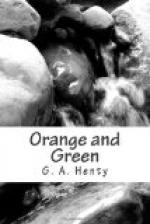The Irish had, this time, determined to defend not only that portion of Athlone situated on the west of the river, but the English town on the east. The fortifications here were repaired and added to, and the town was abundantly supplied with stores and ammunition. It was, however, unable to resist the heavy artillery which Ginckle brought to play against it. Walls, buildings, and towers crumbled beneath the heavy cannonade; and although the Irish repelled, with great slaughter, several assaults upon it, the place became at last untenable, and they abandoned that part of the town, and retired by the bridge across the river to the Irish town.
The British, on entering the eastern town, found it a mere mass of ruins, with the dead bodies of the soldiers lying everywhere, half covered with the wreck of the works they had died in defending. The taking of this portion of Athlone had cost Ginckle dearly, and he was but little nearer the object of his efforts, for he was separated from the Irish town by the Shannon, and the western arch of the bridge was broken down by the defenders.
Eleven large guns and three mortars now came up from Dublin, and he erected a succession of batteries upon the ruins of the English town, and opened fire upon the castle of Athlone, which, although a building of great strength, soon crumbled into ruins beneath the fire of the heavy artillery brought to bear upon it. A mill, which stood in the river, and was connected with the bridge, was set on fire, and the sixty soldiers posted in it, being unable to escape, were all burned. Night and day, seven great batteries played incessantly upon the town.
On the 26th of June, thirty waggons loaded with powder and a hundred carts with cannon balls arrived from Dublin, and enabled the besiegers to keep up their fire without intermission. The interior of the town was reduced to ruins—nothing remained erect save the city walls, in which the breaches, as fast as they were made, were repaired by the Irish. The slaughter among those so employed was very heavy; but there was no lack of men, the places of those who fell being at once supplied by others willing to give their lives in the defence of the town.
At last, there was nothing more that the besiegers could do. The town was reduced to ashes, but the river and the broken arch still separated them from the ruins. To remain much longer where they were was impossible, for the country on every side was exhausted, and no longer afforded food for man or horse. The country people had fled, from the cruelty and spoliation of Ginckle’s foreign soldiery, carrying with them all their effects; and the Irish light troops and armed peasantry hovered round the camp, laid the country waste, and intercepted their supplies and communications with Dublin.
Ginckle held a council of war, to consider what was to be done. It was admitted that they must force the passage of the river without loss of time, or submit to the alternative of retreat, and the utter failure of the campaign. It was finally resolved to attempt the passage of the bridge by throwing a wooden gallery over the broken arch, and forcing their way across, at all cost. Additional batteries were now raised on the bank of the river, and a heavy fire was poured, without intermission, upon the Irish on their side of the broken arch.




